
About Coronavirus Disease 2019 (COVID-19)
Latest Updates on his Outbreak
COVID-19 is a new disease and we are still learning how it spreads, the severity of illness it causes, and to what extent it may spread in the United States.
The virus is thought to spread mainly from person-to-person.
• Between people who are in close contact with one another (within about 6 feet).
• Through respiratory droplets produced when an infected person coughs or sneezes.
These droplets can land in the mouths or noses of people who are nearby or possibly be inhaled into the lungs.
Can someone spread the virus without being sick?
• People are thought to be most contagious when they are most symptomatic (the sickest).
• Some spread might be possible before people show symptoms; there have been reports of this occurring with this new coronavirus, but this is not thought to be the main way the virus spreads.
Spread from contact with contaminated surfaces or objects
It may be possible that a person can get COVID-19 by touching a surface or object that has the virus on it and then touching their own mouth, nose, or possibly their eyes, but this is not thought to be the main way the virus spreads.
How easily a virus spreads from person-to-person can vary. Some viruses are highly contagious (spread easily), like measles, while other viruses do not spread as easily. Another factor is whether the spread is sustained, spreading continually without stopping.
The virus that causes COVID-19 seems to be spreading easily and sustainably in the community (“community spread”) in some affected geographic areas.
Community spread means people have been infected with the virus in an area, including some who are not sure how or where they became infected.
• In addition to CDC, many public health laboratories are now testing for the virus that causes COVID-19. View CDC’s Public Health Laboratory Testing map.
• With this increase in testing, now 19 states have reported cases of COVID-19 to CDC. View latest case counts, deaths, and a map of states with reported cases.
• U.S. COVID-19 cases include:
○ Imported cases in travelers
○ Cases among close contacts of a known case
○ Community-acquired cases where the source of the infection is unknown.
International Areas with Sustained (Ongoing) Transmission
• China (Level 3 Travel Health Notice)
• Iran (Level 3 Travel Health Notice)
• Italy (Level 3 Travel Health Notice)
• Japan (Level 2 Travel Health Notice)
• South Korea (Level 3 Travel Health Notice)
Reported illnesses have ranged from mild symptoms to severe illness and death for confirmed coronavirus disease 2019 (COVID-19) cases.
The following symptoms may appear 2-14 days after exposure.*
• Fever
• Cough
• Shortness of breath

 Call your doctor if you…
Call your doctor if you…
Develop symptoms, and have been in close contact with a person known to have COVID-19
OR
Have recently traveled from an area with widespread or ongoing community spread of COVID-19.
More information
• Schools
Stop the spread of germs
What to do if you are sick
There is currently no vaccine to prevent coronavirus disease 2019 (COVID-19).
The best way to prevent illness is to avoid being exposed to this virus.
The virus is thought to spread mainly from person-to-person.
• Between people who are in close contact with one another (within about 6 feet).
• Through respiratory droplets produced when an infected person coughs or sneezes.
These droplets can land in the mouths or noses of people who are nearby or possibly be inhaled into the lungs.
 Older adults and people who have severe underlying chronic medical conditions like heart or lung disease or diabetes seem to be at higher risk for developing more serious complications from COVID-19 illness. Please consult with your health care provider about additional steps you may be able to take to protect yourself.
Older adults and people who have severe underlying chronic medical conditions like heart or lung disease or diabetes seem to be at higher risk for developing more serious complications from COVID-19 illness. Please consult with your health care provider about additional steps you may be able to take to protect yourself.
Take steps to protect yourself
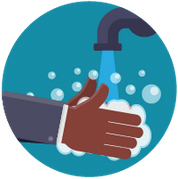
• Wash your hands often with soap and water for at least 20 seconds especially after you have been in a public place, or after blowing your nose, coughing, or sneezing.
• If soap and water are not readily available, use a hand sanitizer that contains at least 60% alcohol. Cover all surfaces of your hands and rub them together until they feel dry.
• Avoid touching your eyes, nose, and mouth with unwashed hands.
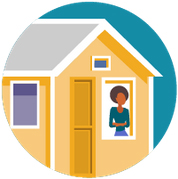
• Avoid close contact with people who are sick
• Put distance between yourself and other people if COVID-19 is spreading in your community. This is especially important for people who are at higher risk of getting very sick.
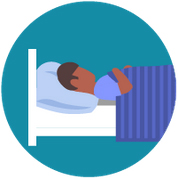
• Stay home if you are sick, except to get medical care. Learn what to do if you are sick.
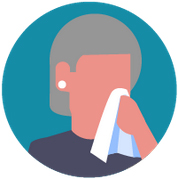
• Cover your mouth and nose with a tissue when you cough or sneeze or use the inside of your elbow.
• Throw used tissues in the trash.
• Immediately wash your hands with soap and water for at least 20 seconds. If soap and water are not readily available, clean your hands with a hand sanitizer that contains at least 60% alcohol.
Wear a facemask if you are sick
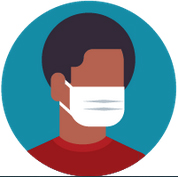
• If you are sick: You should wear a facemask when you are around other people (e.g., sharing a room or vehicle) and before you enter a healthcare provider’s office. If you are not able to wear a facemask (for example, because it causes trouble breathing), then you should do your best to cover your coughs and sneezes, and people who are caring for you should wear a facemask if they enter your room. Learn what to do if you are sick.
• If you are NOT sick: You do not need to wear a facemask unless you are caring for someone who is sick (and they are not able to wear a facemask). Facemasks may be in short supply and they should be saved for caregivers.
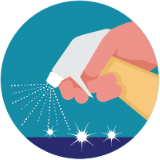
• Clean AND disinfect frequently touched surfaces daily. This includes tables, doorknobs, light switches, countertops, handles, desks, phones, keyboards, toilets, faucets, and sinks.
• If surfaces are dirty, clean them: Use detergent or soap and water prior to disinfection.
To disinfect:
Most common EPA-registered household disinfectants will work. Use disinfectants appropriate for the surface.
Options include:
• Diluting your household bleach.
• To make a bleach solution, mix:
○ 5 tablespoons (1/3rd cup) bleach per gallon of water
○ OR
○ 4 teaspoons bleach per quart of water
• Follow manufacturer’s instructions for application and proper ventilation. Check to ensure the product is not past its expiration date. Never mix household bleach with ammonia or any other cleanser. Unexpired household bleach will be effective against coronaviruses when properly diluted.
• Alcohol solutions.
• Ensure solution has at least 70% alcohol.
• Other common EPA-registered household disinfectants.
• Products with EPA-approved emerging viral pathogens [7 pages] claims are expected to be effective against COVID-19 based on data for harder to kill viruses. Follow the manufacturer’s instructions for all cleaning and disinfection products (e.g., concentration, application method and contact time, etc.).
Complete disinfection guidance
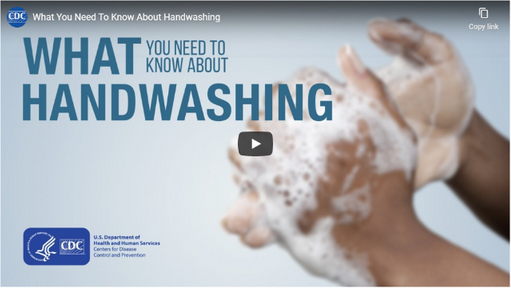
Hand Hygiene in Healthcare Settings
Prevent the spread of COVID-19 if you are sick
 Call your doctor: If you think you have been exposed to COVID-19 and develop a fever1 and symptoms of respiratory illness, such as cough or difficulty breathing, call your healthcare provider immediately.
Call your doctor: If you think you have been exposed to COVID-19 and develop a fever1 and symptoms of respiratory illness, such as cough or difficulty breathing, call your healthcare provider immediately.
Steps to help prevent the spread of COVID-19 if you are sick
Follow the steps below: If you are sick with COVID-19 or suspect you are infected with the virus that causes COVID-19, follow the steps below to help prevent the disease from spreading to people in your home and community.
Stay home except to get medical care
Stay home: People who are mildly ill with COVID-19 are able to isolate at home during their illness. You should restrict activities outside your home, except for getting medical care.
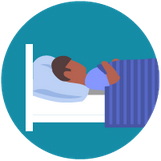
• Avoid public areas: Do not go to work, school, or public areas.
• Avoid public transportation: Avoid using public transportation, ride-sharing, or taxis.
Separate yourself from other people and animals in your home
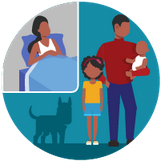
• Stay away from others: As much as possible, you should stay in a specific room and away from other people in your home. Also, you should use a separate bathroom, if available.
• Limit contact with pets & animals: You should restrict contact with pets and other animals while you are sick with COVID-19, just like you would around other people. Although there have not been reports of pets or other animals becoming sick with COVID-19, it is still recommended that people sick with COVID-19 limit contact with animals until more information is known about the virus.
•When possible, have another member of your household care for your animals while you are sick. If you are sick with COVID-19, avoid contact with your pet, including petting, snuggling, being kissed or licked, and sharing food. If you must care for your pet or be around animals while you are sick, wash your hands before and after you interact with pets and wear a facemask. See COVID-19 and Animals for more information.
Information for Household Members and Caregivers of Someone who is Sick
Call ahead before visiting your doctor
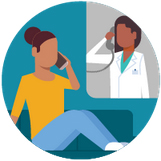
• Call ahead: If you have a medical appointment, call the healthcare provider and tell them that you have or may have COVID-19. This will help the healthcare provider’s office take steps to keep other people from getting infected or exposed.
Wear a facemask if you are sick
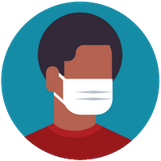
• If you are sick: You should wear a facemask when you are around other people (e.g., sharing a room or vehicle) or pets and before you enter a healthcare provider’s office.
• If you are caring for others: If the person who is sick is not able to wear a facemask (for example, because it causes trouble breathing), then people who live with the person who is sick should not stay in the same room with them, or they should wear a facemask if they enter a room with the person who is sick.
Cover your coughs and sneezes
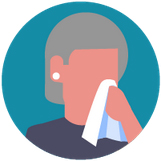
• Cover: Cover your mouth and nose with a tissue when you cough or sneeze.
• Dispose: Throw used tissues in a lined trash can.
• Wash hands: Immediately wash your hands with soap and water for at least 20 seconds or, if soap and water are not available, clean your hands with an alcohol-based hand sanitizer that contains at least 60% alcohol.
Clean your hands often
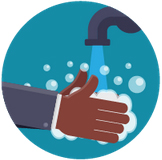
• Wash hands: Wash your hands often with soap and water for at least 20 seconds, especially after blowing your nose, coughing, or sneezing; going to the bathroom; and before eating or preparing food.
• Hand sanitizer: If soap and water are not readily available, use an alcohol-based hand sanitizer with at least 60% alcohol, covering all surfaces of your hands and rubbing them together until they feel dry.
• Soap and water: Soap and water are the best option if hands are visibly dirty.
• Avoid touching: Avoid touching your eyes, nose, and mouth with unwashed hands.
Avoid sharing personal household items
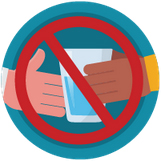
• Do not share: You should not share dishes, drinking glasses, cups, eating utensils, towels, or bedding with other people or pets in your home.
• Wash thoroughly after use: After using these items, they should be washed thoroughly with soap and water.
Clean all “high-touc h” surfaces everyday
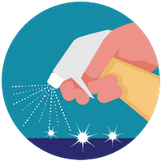
• Clean and disinfect: Practice routine cleaning of high touch surfaces.
High touch surfaces include counters, tabletops, doorknobs, bathroom fixtures, toilets, phones, keyboards, tablets, and bedside tables.
• Disinfect areas with bodily fluids: Also, clean any surfaces that may have blood, stool, or body fluids on them.
• Household cleaners: Use a household cleaning spray or wipe, according to the label instructions. Labels contain instructions for safe and effective use of the cleaning product including precautions you should take when applying the product, such as wearing gloves and making sure you have good ventilation during use of the product.
Complete disinfection guidance
Monitor your symptoms
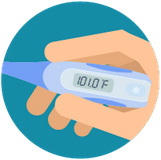
• Seek medical attention: Seek prompt medical attention if your illness is worsening (e.g., difficulty breathing).
• Call your doctor: Before seeking care, call your healthcare provider and tell them that you have, or are being evaluated for, COVID-19.
• Wear a facemask when sick: Put on a facemask before you enter the facility. These steps will help the healthcare provider’s office to keep other people in the office or waiting room from getting infected or exposed.
• Alert health department: Ask your healthcare provider to call the local or state health department. Persons who are placed under active monitoring or facilitated self-monitoring should follow instructions provided by their local health department or occupational health professionals, as appropriate.
 Call 911 if you have a medical emergency: If you have a medical emergency and need to call 911, notify the dispatch personnel that you have, or are being evaluated for COVID-19. If possible, put on a facemask before emergency medical services arrive.
Call 911 if you have a medical emergency: If you have a medical emergency and need to call 911, notify the dispatch personnel that you have, or are being evaluated for COVID-19. If possible, put on a facemask before emergency medical services arrive.
Discontinuing home isolation
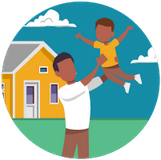
• Stay at home until instructed to leave: Patients with confirmed COVID-19 should remain under home isolation precautions until the risk of secondary transmission to others is thought to be low.
• Talk to your healthcare provider: The decision to discontinue home isolation precautions should be made on a case-by-case basis, in consultation with healthcare providers and state and local health departments.
Public health emergencies, such as the outbreak of coronavirus disease 2019 (COVID-19), are stressful times for people and communities. Fear and anxiety about a disease can lead to social stigma (1) toward people, places, or things. For example, stigma and discrimination can occur when people associate a disease, such as COVID-19, with a population or nationality, even though not everyone in that population or from that region is specifically at risk for the disease. Stigma can also occur after a person has been released from COVID-19 quarantine even though they are not considered a risk for spreading the virus to others.
It is important to remember that people – including those of Asian descent – who do not live in or have not recently been in an area of ongoing spread of the virus that causes COVID-19, or have not been in contact with a person who is a confirmed or suspected case of COVID-19 are not at greater risk of spreading COVID-19 than other Americans.
Some groups of people who may be experiencing stigma because of COVID-19 include:
• Persons of Asian descent
• People who have traveled
• Emergency responders or healthcare professionals
Stigma hurts everyone by creating fear or anger towards other people.
Stigmatized groups may be subjected to:
• Social avoidance or rejection
• Denials of healthcare, education, housing or employment
• Physical violence.
Stigma affects the emotional or mental health (2) of stigmatized groups and the communities they live in. Stopping stigma is important to making communities and community members resilient (3). See resources on mental health and coping during COVID-19.
Everyone can help stop stigma related to COVID-19 by knowing the facts and sharing them with others in your community.
Communicators and public health officials can help counter stigma during the COVID-19 response.
• Maintain privacy and confidentiality of those seeking healthcare and those who may be part of any contact investigation.
• Quickly communicate the risk or lack of risk from associations with products, people, and places.
• Raise awareness about COVID-19 without increasing fear.
• Share accurate information about how the virus spreads.
• Speak out against negative behaviors, including negative statements on social media about groups of people, or exclusion of people who pose no risk from regular activities.
• Be cautious about the images that are shared. Make sure they do not reinforce stereotypes.
• Engage with stigmatized groups in person and through media channels including news media and social media.
• Thank healthcare workers and responders. People who have traveled to areas where the COVID-19 outbreak is happening to help have performed a valuable service to everyone by helping make sure this disease does not spread further.
• Share the need for social support for people who have returned from China or are worried about friends or relatives in the affected region.
1. Stigma occurs when people associate a risk with a specific people, place, or thing – like a minority population group – and there is no evidence that the risk is greater in that group than in the general population. Stigmatization is especially common in disease outbreaks. (https://emergency.cdc.gov/cerc/cerccorner/article_123016.asp)
2. Resilience is the ability to withstand and recover from stress. (https://blogs.cdc.gov/publichealthmatters/2017/08/predicting-community-resilience-and-recovery-after-a-disaster/)
3. Mental health is defined by the World Health Organization as a state of well being in which a person realizes his or her own abilities, can cope with normal stresses of life, can work productively and fruitfully, and is able to make a contribution to his or her community (https://www.who.int/news-room/fact-sheets/detail/mental-health-strengthening-our-response).
Mental Health and Coping During COVID-19
The outbreak of coronavirus disease 2019 (COVID-19) may be stressful for people and communities. Fear and anxiety about a disease can be overwhelming and cause strong emotions in adults and children.
Everyone reacts differently to stressful situations. The emotional impact of an emergency on a person can depend on the person’s characteristics and experiences, the social and economic circumstances of the person and their community, and the availability of local resources. People can become more distressed if they see repeated images or hear repeated reports about the outbreak in the media.
People who may respond more strongly to the stress of a crisis include:
• People who have preexisting mental health conditions including problems with substance use
• Children
• People who are helping with the response to COVID-19, like doctors and other health care providers, or first responders
Additional information and resources on mental health care can be found at the Substance Abuse and Mental Health Services Administration (SAMHSA) website.
• Substance Abuse and Mental Health Services Administration’s (SAMHSA’s) Disaster Distress Hotline: 1-800-985-5990 or text TalkWithUs to 66746.
• People with deafness or hearing loss can use their preferred relay service to call 1-800-985-5990.
Reactions during an infectious disease outbreak can include:
• Fear and worry about your own health status and that of your loved ones who may have been exposed to COVID-19
• Changes in sleep or eating patterns
• Difficulty sleeping or concentrating
• Worsening of chronic health problems
• Increased use of alcohol, tobacco, or other drugs
People with preexisting mental health conditions should continue with their treatment plans during an emergency and monitor for any new symptoms. Additional information can be found at the Substance Abuse and Mental Health Services Administration (SAMHSA) website.
Coping with these feelings and getting help when you need it will help you, your family, and your community recover from a disaster. Connect with family, friends, and others in your community. Take care of yourself and each other, and know when and how to seek help.
Call your healthcare provider if stress reactions interfere with your daily activities for several days in a row.
Things you can do to support yourself:
• Avoid excessive exposure to media coverage of COVID-19.
• Take care of your body. Take deep breaths, stretch or meditate. Try to eat healthy, well-balanced meals, exercise regularly, get plenty of sleep and avoid alcohol and drugs.
• Make time to unwind and remind yourself that strong feelings will fade. Take breaks from watching, reading, or listening to news stories. It can be upsetting to hear about the crisis and see images repeatedly. Try to do some other activities you enjoy to return to your normal life.
• Connect with others. Share your concerns and how you are feeling with a friend or family member. Maintain healthy relationships.
• Maintain a sense of hope and positive thinking.
Share the facts about COVID-19 and the actual risk to others. People who have returned from areas of ongoing spread more than 14 days ago and do not have symptoms of COVID-19 do not put others at risk.
What are quarantine and social distancing?
• Quarantine separates and restricts the movement of people who were exposed to a contagious disease to see if they become sick.
• Social distancing means remaining out of places where people meet or gather, avoiding local public transportation (e.g., bus, subway, taxi, rideshare), and maintaining distance (approximately 6 feet or 2 meters) from others.
Sharing accurate information can help calm fears in others and allow you to connect with them.
Learn more about taking care of your emotional health.
For parents:
Children react, in part, on what they see from the adults around them. When parents and caregivers deal with the COVID-19 calmly and confidently, they can provide the best support for their children. Parents can be more reassuring to others around them, especially children, if they are better prepared.
Not all children respond to stress in the same way. Some common changes to watch for in children:
• Excessive crying and irritation
• Returning to behaviors they have outgrown (e.g., toileting accidents or bedwetting)
• Excessive worry or sadness
• Unhealthy eating or sleeping habits
• Irritability and “acting out” behaviors
• Poor school performance or avoiding school
• Difficulty with attention and concentration
• Avoidance of activities enjoyed in the past
• Unexplained headaches or body pain
• Use of alcohol, tobacco, or other drugs
There are many things you can do to support your child:
• Take time to talk with your child about the COVID-19 outbreak. Answer questions and share facts about COVID-19 in a way that your child can understand.
• Reassure your child that they are safe. Let them know if is ok if they feel upset. Share with them how you deal with your own stress so that they can learn how to cope from you.
• Limit your child’s exposure to media coverage of the event. Children may misinterpret what they hear and can be frightened about something they do not understand.
• Help your child to have a sense of structure. Once it is safe to return to school or child care, help them return to their regular activity.
• Be a role model; take breaks, get plenty of sleep, exercise, and eat well. Connect with your friends and family members and rely on your social support system.
Learn more about helping children cope.
For responders:
Responding to COVID-19 can take an emotional toll on you. There are things you can do to reduce secondary traumatic stress (STS) reactions:
• Acknowledge that STS can impact anyone helping families after a traumatic event.
• Learn the symptoms including physical (fatigue, illness) and mental (fear, withdrawal, guilt).
• Allow time for you and your family to recover from responding to the outbreak.
• Create a menu of personal self-care activities that you enjoy, such as spending time with friends and family, exercising, or reading a book.
• Take a break from media coverage of COVID-19.
• Ask for help if you feel overwhelmed or concerned that COVID-19 is affecting your ability to care for your family and patients as you did before the outbreak.
For people who have been released from quarantine:
Being separated from others if a health care provider thinks you may have been exposed to COVID-19 can be stressful, even if you do not get sick. Some typical reactions after being released from COVID-19 quarantine can include:
• Mixed emotions, including relief after quarantine
• Fear and worry about your own health status and that of your loved ones who may have been exposed to COVID-19
• Stress from the experience of monitoring yourself, or being monitored by others for signs and symptoms of COVID-19
• Sadness, anger, or frustration because friends or loved ones have unfounded fears of contracting the disease from contact with you, even though you have been determined not to be contagious
• Guilt about not being able to perform normal work or parenting duties during quarantine
• Other emotional or mental health changes
Children may also feel upset or have other strong emotions if they, or someone they know, has been released from quarantine. You can help your child cope.
Learn more tips for taking care of yourself during emergency response.
Know the facts about coronavirus disease 2019 (COVID-19) and help stop the spread of rumors.
For up-to-date information, visit CDC’s coronavirus disease 2019 situation summary page.
Fact 1
Diseases can make anyone sick regardless of their race or ethnicity.
People of Asian descent, including Chinese Americans, are not more likely to get COVID-19 than any other American. Help stop fear by letting people know that being of Asian descent does not increase the chance of getting or spreading COVID-19.
Fact 2
Some people are at increased risk of getting COVID-19.
People who have been in close contact with a person known to have COVID-19 or people who live in or have recently been in an area with ongoing spread are at an increased risk of exposure.
Fact 3
Someone who has completed quarantine or has been released from isolation does not pose a risk of infection to other people.
For up-to-date information, visit CDC’s coronavirus disease situation summary page.
Fact 4
You can help stop COVID-19 by knowing the signs and symptoms:
• Fever
• Cough
• Shortness of breath
Seek medical advice if you
• Develop symptoms
AND
• Have been in close contact with a person known to have COVID-19 or live in or have recently traveled from an area with ongoing spread of COVID-19. Call ahead before you go to a doctor’s office or emergency room. Tell them about your recent travel and your symptoms.
Fact 5
There are simple things you can do to help keep yourself and others healthy.
• Wash your hands often with soap and water for at least 20 seconds, especially after blowing your nose, coughing, or sneezing; going to the bathroom; and before eating or preparing food.
• Avoid touching your eyes, nose, and mouth with unwashed hands.
• Stay home when you are sick.
• Cover your cough or sneeze with a tissue, then throw the tissue in the trash.
Frequently Asked Questions and Answers
Coronavirus Disease 2019 Basics
Healthcare Professionals and Health Departments
Other Frequently Asked Questions and Answers About:
K-12 Schools and Childcare Program Administrators
Coronavirus Disease 2019 Basics
What is a novel coronavirus?
A novel coronavirus is a new coronavirus that has not been previously identified. The virus causing coronavirus disease 2019 (COVID-19), is not the same as the coronaviruses that commonly circulate among humans and cause mild illness, like the common cold.
A diagnosis with coronavirus 229E, NL63, OC43, or HKU1 is not the same as a COVID-19 diagnosis. Patients with COVID-19 will be evaluated and cared for differently than patients with common coronavirus diagnosis.
Why is the disease being called coronavirus disease 2019, COVID-19?
On February 11, 2020 the World Health Organization announced an official name for the disease that is causing the 2019 novel coronavirus outbreak, first identified in Wuhan China. The new name of this disease is coronavirus disease 2019, abbreviated as COVID-19. In COVID-19, ‘CO’ stands for ‘corona,’ ‘VI’ for ‘virus,’ and ‘D’ for disease. Formerly, this disease was referred to as “2019 novel coronavirus” or “2019-nCoV”.
There are many types of human coronaviruses including some that commonly cause mild upper-respiratory tract illnesses. COVID-19 is a new disease, caused be a novel (or new) coronavirus that has not previously been seen in humans. The name of this disease was selected following the World Health Organization (WHO) best practice for naming of new human infectious diseases.
Why might someone blame or avoid individuals and groups (create stigma) because of COVID-19?
People in the U.S. may be worried or anxious about friends and relatives who are living in or visiting areas where COVID-19 is spreading. Some people are worried about the disease. Fear and anxiety can lead to social stigma, for example, towards Chinese or other Asian Americans or people who were in quarantine.
Stigma is discrimination against an identifiable group of people, a place, or a nation. Stigma is associated with a lack of knowledge about how COVID-19 spreads, a need to blame someone, fears about disease and death, and gossip that spreads rumors and myths.
Stigma hurts everyone by creating more fear or anger towards ordinary people instead of the disease that is causing the problem.
People can fight stigma and help, not hurt, others by providing social support. Counter stigma by learning and sharing facts. Communicating the facts that viruses do not target specific racial or ethnic groups and how COVID-19 actually spreads can help stop stigma.
What is the source of the virus?
Coronaviruses are a large family of viruses. Some cause illness in people, and others, such as canine and feline coronaviruses, only infect animals. Rarely, animal coronaviruses that infect animals have emerged to infect people and can spread between people. This is suspected to have occurred for the virus that causes COVID-19. Middle East Respiratory Syndrome (MERS) and Severe Acute Respiratory Syndrome (SARS) are two other examples of coronaviruses that originated from animals and then spread to people. More information about the source and spread of COVID-19 is available on the Situation Summary: Source and Spread of the Virus.
How does the virus spread?
This virus was first detected in Wuhan City, Hubei Province, China. The first infections were linked to a live animal market, but the virus is now spreading from person-to-person. It’s important to note that person-to-person spread can happen on a continuum. Some viruses are highly contagious (like measles), while other viruses are less so.
The virus that causes COVID-19 seems to be spreading easily and sustainably in the community (“community spread”) in some affected geographic areas. Community spread means people have been infected with the virus in an area, including some who are not sure how or where they became infected.
Learn what is known about the spread of newly emerged coronaviruses.
Can someone who has had COVID-19 spread the illness to others?
The virus that causes COVID-19 is spreading from person-to-person. Someone who is actively sick with COVID-19 can spread the illness to others. That is why CDC recommends that these patients be isolated either in the hospital or at home (depending on how sick they are) until they are better and no longer pose a risk of infecting others.
How long someone is actively sick can vary so the decision on when to release someone from isolation is made on a case-by-case basis in consultation with doctors, infection prevention and control experts, and public health officials and involves considering specifics of each situation including disease severity, illness signs and symptoms, and results of laboratory testing for that patient.
Current CDC guidance for when it is OK to release someone from isolation is made on a case by case basis and includes meeting all of the following requirements:
• The patient is free from fever without the use of fever-reducing medications.
• The patient is no longer showing symptoms, including cough. The patient has tested negative on at least two consecutive respiratory specimens collected at least 24 hours apart.
Someone who has been released from isolation is not considered to pose a risk of infection to others.
Can someone who has been quarantined for COVID-19 spread the illness to others?
Quarantine means separating a person or group of people who have been exposed to a contagious disease but have not developed illness (symptoms) from others who have not been exposed, in order to prevent the possible spread of that disease. Quarantine is usually established for the incubation period of the communicable disease, which is the span of time during which people have developed illness after exposure. For COVID-19, the period of quarantine is 14 days from the last date of exposure, because 14 days is the longest incubation period seen for similar coronaviruses. Someone who has been released from COVID-19 quarantine is not considered a risk for spreading the virus to others because they have not developed illness during the incubation period.
Can the virus that causes COVID-19 be spread through food, including refrigerated or frozen food?
Coronaviruses are generally thought to be spread from person-to-person through respiratory droplets. Currently there is no evidence to support transmission of COVID-19 associated with food. Before preparing or eating food it is important to always wash your hands with soap and water for 20 seconds for general food safety. Throughout the day wash your hands after blowing your nose, coughing or sneezing, or going to the bathroom.
It may be possible that a person can get COVID-19 by touching a surface or object that has the virus on it and then touching their own mouth, nose, or possibly their eyes, but this is not thought to be the main way the virus spreads.
In general, because of poor survivability of these coronaviruses on surfaces, there is likely very low risk of spread from food products or packaging that are shipped over a period of days or weeks at ambient, refrigerated, or frozen temperatures.
Learn what is known about the spread of COVID-19.
Will warm weather stop the outbreak of COVID-19?
It is not yet known whether weather and temperature impact the spread of COVID-19. Some other viruses, like the common cold and flu, spread more during cold weather months but that does not mean it is impossible to become sick with these viruses during other months. At this time, it is not known whether the spread of COVID-19 will decrease when weather becomes warmer. There is much more to learn about the transmissibility, severity, and other features associated with COVID-19 and investigations are ongoing.
What is community spread?
Community spread means people have been infected with the virus in an area, including some who are not sure how or where they became infected.
Am I at risk for COVID-19 in the United States?
This is a rapidly evolving situation and the risk assessment may change daily. The latest updates are available on CDC’s Coronavirus Disease 2019 (COVID-19) website.
Has anyone in the United States gotten infected?
Yes. There have been cases of COVID-19 in the U.S. related to travel and person-to-person spread. U.S. case counts are updated regularly on Mondays, Wednesday, and Fridays. See the current U.S. case count of COVID-19.
How can I help protect myself?
Visit the COVID-19 Prevention and Treatment page to learn about how to protect yourself from respiratory illnesses, like COVID-19.
What should I do if I had close contact with someone who has 2019-nCoV?
There is information for people who have had close contact with a person confirmed to have, or being evaluated for, COVID-19 available online.
Who is at higher risk for serious illness from COVID-19?
Early information out of China, where COVID-19 first started, shows that some people are at higher risk of getting very sick from this illness including older adults, and people who have serious chronic medical conditions like heart disease, diabetes, and lung disease.
What should people at higher risk of serious illness with COVID-19 do?
If you are at higher risk of getting very sick from COVID-19, you should: stock up on supplies; take everyday precautions to keep space between yourself and others; when you go out in public, keep away from others who are sick; limit close contact and wash your hands often; and avoid crowds, cruise travel, and non-essential travel. If there is an outbreak in your community, stay home as much as possible. Watch for symptoms and emergency signs. Watch for symptoms and emergency signs. If you get sick, stay home and call your doctor. More information on how to prepare, what to do if you get sick, and how communities and caregivers can support those at higher risk is available on People at Risk for Serious Illness from COVID-19.
Does CDC recommend the use of facemask to prevent COVID-19?
CDC does not recommend that people who are well wear a facemask to protect themselves from respiratory illnesses, including COVID-19. You should only wear a mask if a healthcare professional recommends it. A facemask should be used by people who have COVID-19 and are showing symptoms. This is to protect others from the risk of getting infected. The use of facemasks also is crucial for health workers and other people who are taking care of someone infected with COVID-19 in close settings (at home or in a health care facility).
Am I at risk for COVID-19 from a package or products shipping from China?
There is still a lot that is unknown about the newly emerged COVID-19 and how it spreads. Two other coronaviruses have emerged previously to cause severe illness in people (MERS-CoV and SARS-CoV). The virus that causes COVID-19 is more genetically related to SARS-CoV than MERS-CoV, but both are betacoronaviruses with their origins in bats. While we don’t know for sure that this virus will behave the same way as SARS-CoV and MERS-CoV, we can use the information gained from both of these earlier coronaviruses to guide us. In general, because of poor survivability of these coronaviruses on surfaces, there is likely very low risk of spread from products or packaging that are shipped over a period of days or weeks at ambient temperatures. Coronaviruses are generally thought to be spread most often by respiratory droplets. Currently there is no evidence to support transmission of COVID-19 associated with imported goods and there have not been any cases of COVID-19 in the United States associated with imported goods. Information will be provided on the Coronavirus Disease 2019 (COVID-19) website as it becomes available.
What are the symptoms and complications that COVID-19 can cause?
Current symptoms reported for patients with COVID-19 have included mild to severe respiratory illness with fever1, cough, and difficulty breathing. Read about COVID-19 Symptoms.
Should I be tested for COVID-19?
If you develop symptoms such as fever, cough, and/or difficulty breathing, and have been in close contact with a person known to have COVID-19 or have recently traveled from an area with ongoing spread of COVID-19, stay home and call your healthcare provider. Older patients and individuals who have severe underlying medical conditions or are immunocompromised should contact their healthcare provider early, even if their illness is mild. If you have severe symptoms, such as persistent pain or pressure in the chest, new confusion or inability to arouse, or bluish lips of face, contact your healthcare provider or emergency room and seek care immediately. Your doctor will determine if you have signs and symptoms of COVID-19 and whether you should be tested.
Your healthcare professional will work with your state’s public health department and CDC to determine if you need to be tested for COVID-19.
Can a person test negative and later test positive for COVID-19?
Using the CDC-developed diagnostic test, a negative result means that the virus that causes COVID-19 was not found in the person’s sample. In the early stages of infection, it is possible the virus will not be detected.
For COVID-19, a negative test result for a sample collected while a person has symptoms likely means that the COVID-19 virus is not causing their current illness.
Why might someone blame or avoid individuals and groups (create stigma) because of COVID-19?
People in the U.S. may be worried or anxious about friends and relatives who are living in or visiting areas where COVID-19 is spreading. Some people are worried about the disease. Fear and anxiety can lead to social stigma, for example, towards Chinese or other Asian Americans or people who were in quarantine.
Stigma is discrimination against an identifiable group of people, a place, or a nation. Stigma is associated with a lack of knowledge about how COVID-19 spreads, a need to blame someone, fears about disease and death, and gossip that spreads rumors and myths.
Stigma hurts everyone by creating more fear or anger towards ordinary people instead of the disease that is causing the problem.
How can people help stop stigma related to COVID-19?
People can fight stigma and help, not hurt, others by providing social support. Counter stigma by learning and sharing facts. Communicating the facts that viruses do not target specific racial or ethnic groups and how COVID-19 actually spreads can help stop stigma.
Healthcare Professionals and Health Departments
What should healthcare professionals and health departments do?
For recommendations and guidance on persons under investigation; infection control, including personal protective equipment guidance; home care and isolation; and case investigation, see Information for Healthcare Professionals. For information on specimen collection and shipment, see Information for Laboratories. For information for public health professional on COVID-19, see Information for Public Health Professionals.
Am I at risk if I go to a funeral or visitation service for someone who died of COVID-19?
There is currently no known risk associated with being in the same room at a funeral or visitation service with the body of someone who died of COVID-19.
Am I at risk if I touch someone who died of COVID-19 after they have passed away?
COVID-19 is a new disease and we are still learning how it spreads. The virus that causes COVID-19 is thought to mainly spread from close contact (i.e., within about 6 feet) with a person who is currently sick with COVID-19. The virus likely spreads primarily through respiratory droplets produced when an infected person coughs or sneezes, similar to how influenza and other respiratory infections spread. These droplets can land in the mouths or noses of people who are nearby or possibly be inhaled into the lungs. This type of spread is not a concern after death.
It may be possible that a person can get COVID-19 by touching a surface or object that has the virus on it and then touching their own mouth, nose, or possibly their eyes, but this is not thought to be the main way the virus spreads.
People should consider not touching the body of someone who has died of COVID-19. Older people and people of all ages with severe underlying health conditions are at higher risk of developing serious COVID-19 illness. There may be less of a chance of the virus spreading from certain types of touching, such as holding the hand or hugging after the body has been prepared for viewing. Other activities, such as kissing, washing, and shrouding should be avoided before, during, and after the body has been prepared, if possible. If washing the body or shrouding are important religious or cultural practices, families are encouraged to work with their community cultural and religious leaders and funeral home staff on how to reduce their exposure as much as possible. At a minimum, people conducting these activities should wear disposable gloves. If splashing of fluids is expected, additional personal protective equipment (PPE) may be required (such as disposable gown, faceshield or goggles and facemask).
Cleaning should be conducted in accordance with manufacturer’s instructions for all cleaning and disinfection products (e.g., concentration, application method and contact time, etc.). Products with EPA-approved emerging viral pathogens claims are expected to be effective against COVID-19 based on data for harder to kill viruses. After removal of PPE, perform hand hygiene by washing hands with soap and water for at least 20 seconds or using an alcohol-based hand sanitizer that contains at least 60% alcohol if soap and water are not available. Soap and water should be used if the hands are visibly soiled.
What do Funeral Home Workers need to know about handling decedents who had COVID-19?
A funeral or visitation service can be held for a person who has died of COVID-19. Funeral home workers should follow their routine infection prevention and control precautions when handling a decedent who died of COVID-19. If it is necessary to transfer a body to a bag, follow Standard Precautions, including additional personal protective equipment (PPE) if splashing of fluids is expected. For transporting a body after the body has been bagged, disinfect the outside of the bag with a product with EPA-approved emerging viral pathogens claims expected to be effective against COVID-19 based on data for harder to kill viruses. Follow the manufacturer’s instructions for all cleaning and disinfection products (e.g., concentration, application method and contact time, etc.). Wear disposable nitrile gloves when handling the body bag.
Embalming can be conducted. During embalming, follow Standard Precautions including the use of additional PPE if splashing is expected (e.g. disposable gown, faceshield or goggles and facemask). Wear appropriate respiratory protection if any procedures will generate aerosols or if required for chemicals used in accordance with the manufacturer’s label. Wear heavy-duty gloves over nitrile disposable gloves if there is a risk of cuts, puncture wounds, or other injuries that break the skin. Additional information on how to safely conduct aerosol-generating procedures is in the CDC’s Postmortem Guidance. Cleaning should be conducted in accordance with manufacturer’s instructions. Products with EPA-approved emerging viral pathogens claims are expected to be effective against COVID-19 based on data for harder to kill viruses. Follow the manufacturer’s instructions for all cleaning and disinfection products (e.g., concentration, application method and contact time, etc.).
After cleaning and removal of PPE, perform hand hygiene by washing hands with soap and water for at least 20 seconds or using an alcohol-based hand sanitizer that contains at least 60% alcohol if soap and water is not available. Soap and water should be used if the hands are visibly soiled.
Decedents with COVID-19 can be buried or cremated, but check for any additional state and local requirements that may dictate the handling and disposition of the remains of individuals who have died of certain infectious diseases.
What should I do if my family member died from COVID-19 while overseas?
When a US citizen dies outside the United States, the deceased person’s next of kin or legal representative should notify US consular officials at the Department of State. Consular personnel are available 24 hours a day, 7 days a week, to provide assistance to US citizens for overseas emergencies. If a family member, domestic partner, or legal representative is in a different country from the deceased person, he or she should call the Department of State’s Office of Overseas Citizens Services in Washington, DC, from 8 am to 5 pm Eastern time, Monday through Friday, at 888-407-4747 (toll-free) or 202-501-4444. For emergency assistance after working hours or on weekends and holidays, call the Department of State switchboard at 202-647-4000 and ask to speak with the Overseas Citizens Services duty officer. In addition, the US embassy closest to or in the country where the US citizen died can provide assistance.
My family member died from COVID-19 while overseas. What are the requirements for returning the body to the United States?
CDC does not require an autopsy before the remains of a person who died overseas are returned to the United States. Depending on the circumstances surrounding the death, some countries may require an autopsy. Sources of support to the family include the local consulate or embassy, travel insurance provider, tour operator, faith-based and aid organizations, and the deceased’s employer. There likely will need to be an official identification of the body and official documents issued by the consular office.
CDC requirements for importing human remains depend upon if the body has been embalmed, cremated, or if the person died from a quarantinable communicable disease.
At this time, COVID-19 is a quarantinable communicable disease in the United States and the remains must meet the standards for importation found in 42 Code of Federal Regulations Part 71.55 and may be cleared, released, and authorized for entry into the United States only under the following conditions:
• The remains are cremated; OR
• The remains are properly embalmed and placed in a hermetically sealed casket; OR
• The remains are accompanied by a permit issued by the CDC Director. The CDC permit (if applicable) must accompany the human remains at all times during shipment.
○ Permits for the importation of the remains of a person known or suspected to have died from a quarantinable communicable disease may be obtained through the CDC Division of Global Migration and Quarantine by calling the CDC Emergency Operations Center at 770-488-7100 or emailing dgmqpolicyoffice@cdc.gov.
Please see CDC’s guidance for additional information.
What is CDC doing about COVID-19?
This is an emerging, rapidly evolving situation and CDC will continue to provide updated information as it becomes available. CDC works 24/7 to protect people’s health. More information about CDC’s response to COVID-19 is available online.
What about animals or animal products imported from China?
CDC does not have any evidence to suggest that animals or animal products imported from China pose a risk for spreading COVID-19 in the United States. This is a rapidly evolving situation and information will be updated as it becomes available. The U.S. Centers for Disease Control and Prevention (CDC), the U. S. Department of Agriculture (USDA), and the U.S. Fish and Wildlife Service (FWS) play distinct but complementary roles in regulating the importation of live animals and animal products into the United States. CDC regulates animals and animal products that pose a threat to human health, USDA regulates animals and animal products that pose a threat to agriculture; and FWS regulates importation of endangered species and wildlife that can harm the health and welfare of humans, the interests of agriculture, horticulture, or forestry, and the welfare and survival of wildlife resources.
Can I travel to the United States with dogs or import dogs into the United States during the COVID-19 outbreak?
Please refer to CDC’s requirements for bringing a dog to the United States. The current requirements for rabies vaccination apply to dogs imported from China, a high-risk country for rabies.
Should I be concerned about pets or other animals and COVID-19?
While this virus seems to have emerged from an animal source, it is now spreading from person-to-person in China. There is no reason to think that any animals including pets in the United States might be a source of infection with this new coronavirus. To date, CDC has not received any reports of pets or other animals becoming sick with COVID-19. At this time, there is no evidence that companion animals including pets can spread COVID-19. However, since animals can spread other diseases to people, it’s always a good idea to wash your hands after being around animals. For more information on the many benefits of pet ownership, as well as staying safe and healthy around animals including pets, livestock, and wildlife, visit CDC’s Healthy Pets, Healthy People website.
Should I avoid contact with pets or other animals if I am sick with COVID-19?
You should restrict contact with pets and other animals while you are sick with COVID-19, just like you would around other people. Although there have not been reports of pets or other animals becoming sick with COVID-19, it is still recommended that people sick with COVID-19 limit contact with animals until more information is known about the virus. When possible, have another member of your household care for your animals while you are sick. If you are sick with COVID-19, avoid contact with your pet, including petting, snuggling, being kissed or licked, and sharing food. If you must care for your pet or be around animals while you are sick, wash your hands before and after you interact with pets and wear a facemask.
What precautions should be taken for animals that have recently been imported (for example, by shelters, rescue groups, or as personal pets) from China?
Animals imported from China will need to meet CDC and USDA requirements for entering the United States. At this time, there is no evidence that companion animals including pets can spread COVID-19. As with any animal introduced to a new environment, animals recently imported from China should be observed daily for signs of illness. If an animal becomes ill, the animal should be examined by a veterinarian. Call your local veterinary clinic before bringing the animal into the clinic and let them know that the animal was recently in China.
Footnotes
* This is based on what has been seen previously as the incubation period of MERS-CoV viruses.
1 Fever may be subjective or confirmed
2 Close contact is defined as—
1. a) being within approximately 6 feet (2 meters) of a COVID-19 case for a prolonged period of time; close contact can occur while caring for, living with, visiting, or sharing a health care waiting area or room with a COVID-19 case
– or –
1. b) having direct contact with infectious secretions of a COVID-19 case (e.g., being coughed on)
If such contact occurs while not wearing recommended personal protective equipment or PPE (e.g., gowns, gloves, NIOSH-certified disposable N95 respirator, eye protection), criteria for PUI consideration are met.